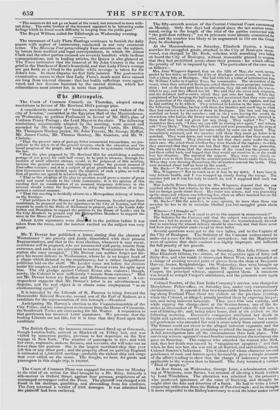The following account of the post moment examination of the
late Lady Flora I lastings, has been published at the desire of her brother, the Marquis.
Appearances observed on inspecting the !solo the late Lady Flora Hastings, Alp 5, 1839.
" There was great emaciation of the whole person, " In the chest : the heart and lungs were in a perfectly healthy state; but there were extensive adhesions of the pleura (or membrane) covering the right lung, to that which lines time ribs—evidently of ion:, stumeiIne " i the abdomen : there were universal of the peritoneum (or membrane which lines time cavity and covers the t h.,eet:;); so that it could not be said that there was a single orgmi villich was not. at oi-ery point on its surface, intimately connected with the parts in it, viHi■iy. The liver was very much enlarged; extending 110WIIWard, IN IOW as the and upwards so as very materially to diminish the capacity of the right cavity of the chest. The gall-bladder contained a small qumnity of hilt. The liver was of a very pale colour, but its structure was not materially clitferent from what exists in the healthy state. The stomach and.n. t est.ocs nvere distended with air; their coats, especially the muscular, were much attenuated. The spleen and pancreas were free from disease. Some of the »iesen tale glands were enlarged. There were a few small deposits of unorganized yellow matter, apparently in the substance of the tullicsions.
" The uterus and its appendages presented the usual appearalleeS of the healthy virgin state. " From the character of the adhesions, it was plain that they could be re- ferred only to inflammation at some former and disiant wrioil of time. The effect of them must have been to in-tempt 111e pass:1.y of t he contents of the stomach and intestines, and in various ways to inrerrere wi;11 the due perform- ance of their functions.
(Signed) " W. F. ensstnEnS, M.D. A sTIA:v COOPER, HENRY HOLLAND, 11.
don 7.; Al Mt It ;sin:N."
Lady Flora's remains were removed front the Palace at an early hour on Wednesday morning.. and conveyed on board the Royal William steam-ship, lying nt St. Katherine's Docks. Even as early as two o'clock a considerable number of spectators were assembled. Lord Brougham's carriage was the first that arrived, soon followed by Lord Rosslyns. In the procession were—rote of the Queen's carriages, and those of Queen Adelaide, the Duchess of Glmhy,t,-7.. the Princess Sophia, the Dutehess of Kent, th,.! Dowager of Richmond, the Marquis of Downshire, Lord Howe, the Marquis cornwallis, Lord Lincoln, Lord Foley, Lord Craven, besides Lord Brougham's and Lord leosslyn's previously mentioned. The further details arc taken verbatim from the Morning Post.
"The procession passed in front of the National Gallery, along West Strand, through Temple Bar, into the City; the crowd increasing wing every street. It then went along Cheapside, and by the most direct. route to tit. Katharine's Wharf.
" The first part of the procession reached Tower Ilill just as the Tower clock was telling six. Here the Royal and other carriages filed off, and re- turned home. Ile hearse, mourning-coaches, and Lord Hastings' and the Marchioness of Cornwallis's carriages, then proceeded to the wharf; where the coffin, which inns enwrapped in Idea cloth, was conveyed within the gates of the packet-station.
" Here the coffin was enelosmd in a strommg wooden c:,s?, some of' the
nearest relatives of the deeettActi beimr c present at the m n• my. A very touching incident here took place. 'dust befiure the workmen commenced screwing down the lid of the box, Lady Sophia 'Listings, who was sup- ported by her brother, stepped forward, and, evidently labouring under strong emotion, which it required all her fortitude to suppress, gently touched the head of the coffin, as if to take a la,t farewell of the mortal remains of her sainted sister. Owing to the state of the tide, the steam-vessel could not be brought alongside of the wharf. The coffin was th:refore lowered into at small boat, and taken out into the stream, where the Royal William lay. "The top of the outer ca:,:! was marked with a sort of hatehment, within which were time initials " F. 14." in large black letters. The following is the inscription on time v[4111— '11111: LADY FLORA ELIZABETH IIACTI NOS, Lady of the Bedchamber to H. R. H. the Dutebess of Kent; Eldest Daughter of Francis Marquis of Hastings ant Flora Countess of Loudoun. Born in Edinburgh, Feb. 11, 1806 ; Died at Buckingham Palace, July 5, 1839 ; Aged 33.
"The mourners did not go on board of the vessel, but returned to town with- out delay. The noble brother of the deceased appeared to be labouring under feelings which he found much difficulty in keeping from the public gaze."
The Royal William sailed for Edinburgh on Wednesday evening.



























 Previous page
Previous page